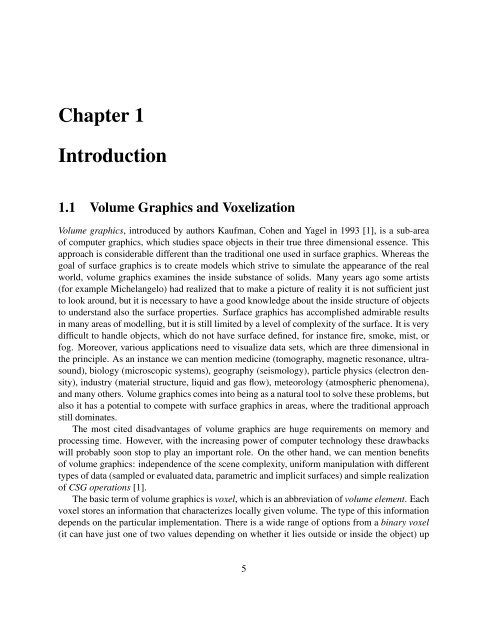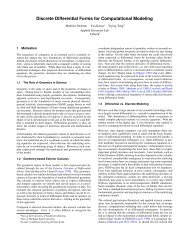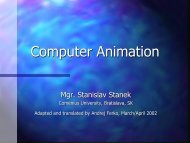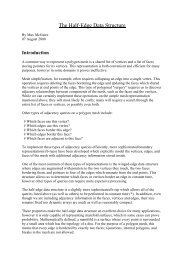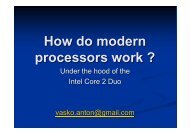Volume Representation by Gradient and Distance Fields - Spring ...
Volume Representation by Gradient and Distance Fields - Spring ...
Volume Representation by Gradient and Distance Fields - Spring ...
Create successful ePaper yourself
Turn your PDF publications into a flip-book with our unique Google optimized e-Paper software.
Chapter 1Introduction1.1 <strong>Volume</strong> Graphics <strong>and</strong> Voxelization<strong>Volume</strong> graphics, introduced <strong>by</strong> authors Kaufman, Cohen <strong>and</strong> Yagel in 1993 [1], is a sub-areaof computer graphics, which studies space objects in their true three dimensional essence. Thisapproach is considerable different than the traditional one used in surface graphics. Whereas thegoal of surface graphics is to create models which strive to simulate the appearance of the realworld, volume graphics examines the inside substance of solids. Many years ago some artists(for example Michelangelo) had realized that to make a picture of reality it is not sufficient justto look around, but it is necessary to have a good knowledge about the inside structure of objectsto underst<strong>and</strong> also the surface properties. Surface graphics has accomplished admirable resultsin many areas of modelling, but it is still limited <strong>by</strong> a level of complexity of the surface. It is verydifficult to h<strong>and</strong>le objects, which do not have surface defined, for instance fire, smoke, mist, orfog. Moreover, various applications need to visualize data sets, which are three dimensional inthe principle. As an instance we can mention medicine (tomography, magnetic resonance, ultrasound),biology (microscopic systems), geography (seismology), particle physics (electron density),industry (material structure, liquid <strong>and</strong> gas flow), meteorology (atmospheric phenomena),<strong>and</strong> many others. <strong>Volume</strong> graphics comes into being as a natural tool to solve these problems, butalso it has a potential to compete with surface graphics in areas, where the traditional approachstill dominates.The most cited disadvantages of volume graphics are huge requirements on memory <strong>and</strong>processing time. However, with the increasing power of computer technology these drawbackswill probably soon stop to play an important role. On the other h<strong>and</strong>, we can mention benefitsof volume graphics: independence of the scene complexity, uniform manipulation with differenttypes of data (sampled or evaluated data, parametric <strong>and</strong> implicit surfaces) <strong>and</strong> simple realizationof CSG operations [1].The basic term of volume graphics is voxel, which is an abbreviation of volume element. Eachvoxel stores an information that characterizes locally given volume. The type of this informationdepends on the particular implementation. There is a wide range of options from a binary voxel(it can have just one of two values depending on whether it lies outside or inside the object) up5


